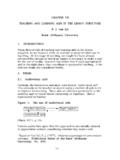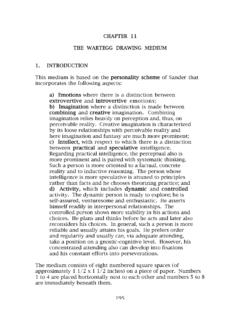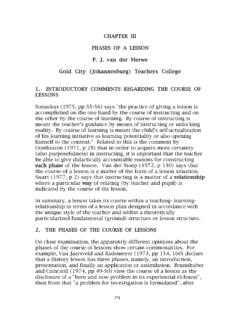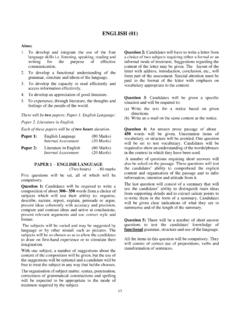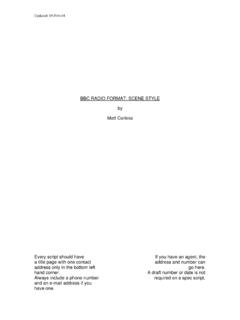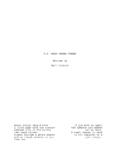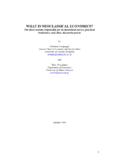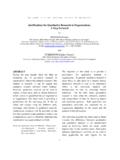Transcription of CHAPTER IV MODES OF TEACHING AND LEARNING …
1 48 CHAPTER IVMODES OF TEACHING AND LEARNINGR. A. KrugerRand Afrikaans University1. INTRODUCTIONA ctualizing the lesson structure amounts to two kinds of activities,namely, TEACHING and LEARNING . These activities can be reduced togeneral forms of human action that also occur outside of a strictlydidactic framework with other than just the aims of TEACHING andlearning. Thus, children and adults, in their spontaneous life worldconversations, ask questions, investigate things and in one way oranother describe objects and experiences to someone else. Theseconversations always are about something; a person poses questionsin order to know and another person points out or describessomething to him. This "something" is the content or substantivecomponent that is the LEARNING content within the framework of LEARNING content (and all life content) is largely coloredculturally and personally.
2 All dealings with content are a normativematter because unlocking and mastering it is prompted by afundamental relationship and directed by the teacher in order toestablish particular fundamental relationships. A life- and world-view also permeates each of our efforts regarding content. Ahierarchy of values or priorities greatly determine which aims areposed and the ways they are going to be this way, a hierarchy of values determines the relationships thatare established so the lesson can proceed. This means that in eachteaching situation, the teacher and the child establish a particularrelationship with each other. If one reasons didactically, this meansthat the relationships established constitute the operationalcomponent of the lesson and that, within these dynamicrelationships, certain MODES of TEACHING and LEARNING occur.
3 Bysuccessively actualizing certain MODES of TEACHING and learningwithin particular relationships the lesson takes on a particularpattern or form. The forms of TEACHING that the relationships49assume in a lesson can be referred back to three basic relationships,namely:(i) a relationship of language-dialogue with conversation as the basic form;(ii) a searching relationship with play as the fundamentalform; and(iii) a demonstration relationship with example as the THE MODES OF TEACHINGFrom the above, it is clear that in TEACHING , particular relationshipswill be established. This means that in a particular phase of alesson, there is a particular way of TEACHING but, at the same time,corresponding MODES of LEARNING are actualized. The teacher'spreference to allow his TEACHING to progress in a certain way will, toan informed observer, characterize his TEACHING style.
4 Theseinsights are of great importance for teacher training. The modesof TEACHING can only find expression in three predominantrelationships, namely, a language-dialogue, a searching ora demonstration relationship.*Should a student teacher's attempts to give lessons show that theyusually can be typified as emanating from a demonstrationrelationship ( , showing, pointing out are dominant), the teachereducator can indicate the dangers of an autocratic way of teachingwhere the tendency is for the teacher to have too great and thepupils to have too little a stake in the lesson. A student whoseteaching in the training lessons usually is typified by viable searchtasks being launched within searching relationships most likely willbe complemented (and hopefully with a high evaluation) from theteacher educator because of his readiness to allow the MODES oflearning to progress as meaningfully as possible and to trust thepupil to find out about and look into things for the above, all TEACHING and all LEARNING activities, in the courseof a lesson and within a lesson structure, can be reduced to one ofthree relationships.
5 However, it is important to recognize that thesethree relationships carry broad connotations. Thus, a language- * Assignment is considered to be a fourth fundamental form ofteaching but can cut across or include the three relationship includes all examples of symbolizedlanguage (language expressed in symbols)--which means thatreading and writing as well as mathematical symbols and numbersare included. All nuances and variations of saying and listening orof establishing communication and understanding as MODES ofinstruction are included--among which are such activities asnarrating, talking, reciting, discussing, asking questions,representing, writing, naming, replying, clarifying, summarizing,listing, outlining, , the demonstration relationship is differentiated by theway the particular and the general are handled.
6 This varies frompointing out the particular for the sake of the particular toindicating the particular for the sake of the general. Also, a modelcan be shown as a representative case because the general as wellas the particular are expressed in it. MODES of TEACHING that typifythe demonstration relationship are described by verbs such asshowing, demonstrating, exemplifying, illustrating, introducing, MODES OF TEACHING IN THE SEARCHING RELATIONSHIPA person really is in a searching relationship with reality for hisentire life. This search is a search for meaning. Thus, it is logicalthat this human inquiry of the world be used as a TEACHING this modality, there is a delving with the child into the wondersof being human and there is a search for answers behind what isapparently of TEACHING that can have a consequence for a searchingrelationship are the use of competitions, puzzles, experiments,literature studies, inquiries and of the MODES of LEARNING (the child's role) that arisefrom a searching relationship is the active and total involvement ofthe learner in the problematic questions.
7 This brings our discussionto the MODES of MODES OF LEARNINGThe second aim of this introduction is to consider the ways learningoccurs (in contrast to TEACHING ). In a broad sense, the MODES oflearning correspond to the MODES of TEACHING . In addition, the51modes of LEARNING occur in particular relationships. Thus, it is easyto see that in a language-dialogue relationship the MODES oflearning will typify the learner as a language using, communicatingperson: this means a person who can (and will) be a conversationalpartner with others, who can ask and answer questions, who canacquire the deepest human thoughts from spoken or writtenlanguage, or who can put deep thoughts into , the learner who is in a lesson situation within ademonstration relationship engages in MODES of LEARNING bywhich things can be demonstrated.
8 In this case, the MODES oflearning are attuned to activities of noticing what is shown andpenetrating to the essentials of what is demonstrated. The optimaluse of the LEARNING opportunity established by a demonstrationrelationship lies in the pupil being able to follow what is beingexplained and to see the sense of what is exemplified in the also are nuances of MODES of LEARNING that can be describedas searching, thus LEARNING activities within a searchingrelationship. In this case, LEARNING will be characterized by a pupil'squestioning attitude directed to searching for what is true, what ismeaningful or discovering how things are put CONCLUSIONSWhat is important to notice in this entire discussion of the MODES ofteaching and LEARNING is that the relationship established betweenteacher and pupil always accentuates one of three aspects, namely, apredominantly language-dialogue, a demonstration or a searchingrelationship.
9 Obviously, these are only distinctions that are madeand, in fact, aspects of all three are present in any views the lesson structure as external to establishingcertain relationships does not yet have a correct perspective on is hoped that this introduction has conveyed the insight that alesson structure only can be implemented when a particularrelationship has been established between teacher and child becauseit is from this relationship that the MODES of TEACHING and learningare actualized.
